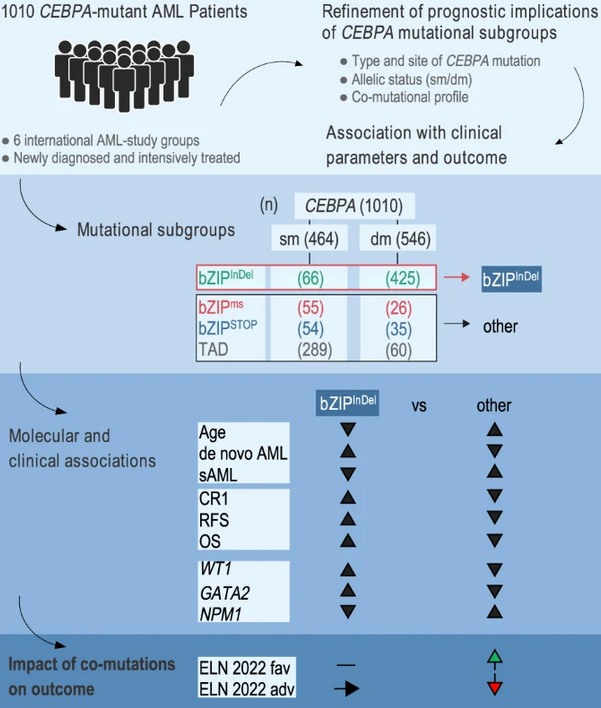Impact of CEBPA mutation patterns on prognosis in adults with acute myeloid leukemia (AML)
- New horizons in leukemia research: Selected papers in focus -
New findings on the prognostic significance of CEBPA mutations in adults with acute myeloid leukemia (AML) show that biallelic mutations are associated with a more favorable disease course. The study by Georgi et al. sheds light on the complex interactions between CEBPA mutation subsets and other genetic alterations to better assess risk and treatment outcomes for disease progression.
Acute myeloid leukaemia (AML) is a heterogeneous disease characterized by various genetic aberrations. Mutations in the CEBPA gene, which codes for a transcription factor involved in the regulation of hematopoiesis, are known to occur in AML patients and can influence the prognosis. However, the exact characterization of these mutations and their influence on prognosis are not yet fully understood. The study by Georgi et al. aimed to investigate the prognostic significance of different CEBPA mutation subgroups in adult AML patients. To this end, anonymized data from 1010 AML patients (aged 16 to 85 years, treated between 1989 and 2019) were compared to assess the CEBPA mutation based on the following factors
- bZIP: typical in-frame insertions/deletions (InDel) mutations (bZIPInDel)
- Frameshift InDel or nonsense mutations that lead to a translation stop (bZIPSTOP) or single base-pair missense alterations (bZIPms)
- Transcription activation domain (TAD) mutations
- Allele status (single (smCEBPA) vs. double mutation (dmCEBPA))
Georgi et al. then grouped AML patients based on their specific CEBPA mutation profiles and compared survival rates and other clinical endpoints between these groups. The results show that different CEBPA mutation subgroups have significantly different prognoses. Only bZIPInDel patients had significantly higher rates of complete remission (CR) and longer overall relapse-free survival compared to the other CEBPA subgroups. Co-mutations in bZIPInDel patients (e.g. GATA2, FLT3, WT1 and ELN2022 risk aberrations) had no independent impact on overall survival, while in non-bZIPInDel patients, grouping by ELN2022 recommendations provided significant prognostic information on relapse-free survival and overall survival.
The study provides important insights into the genetic and clinical heterogeneity of AML and underlines the need for detailed genetic characterization for a more precise prognosis and individualized therapeutic approaches. The results could help to improve risk stratification of AML patients and form the basis for future clinical trials aimed at developing targeted therapies for specific mutation profiles.
Georgi J-A et al. Prognostic impact of CEBPA mutational subgroups in adult AML. Leukemia. 2024 Feb;38(2):281-290.


"If you have any further questions on this topic, please contact us!"
Dr. rer. nat. Constanze Kühn
Medical Writer